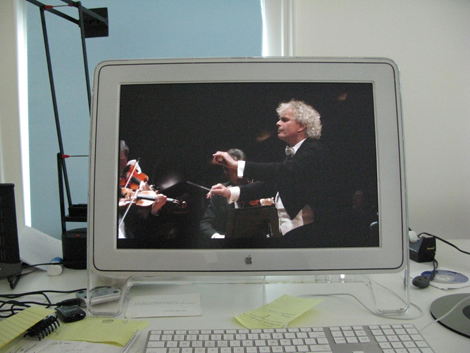
The Berlin Philharmonic at home
It felt vaguely ironic to be sitting before our computer in Germantown, New York, watching the first live internet broadcast from the Digital Concert Hall of the Berliner Philharmoniker, with Sir Simon Rattle conducting Dvorák’s G minor Slavonic Dance and Brahms’s First Symphony.
And wonderful. Being able to be in two places at once was incredible. We were “there” in the concert hall even though we were thousands of miles away. What an amazing altering of time and space. Like all visual recordings of concerts, having one’s attention directed by the camera rather than one’s internal promptings was very different from actually being in the audience, but the intimacy created with conductor and orchestra was a joy. This is a great thing the Berliner Philharmonica has undertaken. The video quality was superb as was the sound. Oh yes, the music was wonderful too.
The decision by the Berliner Philharmoniker to create the Digital Concert Hall is clearly a step many cultural institutions are beginning to undertake to answer the perennial problem of how to stay solvent, survive, in difficult economic times. They are selling seats to an audience that has no geographic limitation. They have increased the seating capacity beyond the restrictions of physical space.
Is this a continuation of the movement to the virtual world, a world where less and less of our physical presence is necessary for an experience? And when does that experience become accepted as how best to “appreciate” the event. Is it better to watch the football game on the TV with HD quality and eventual 3D broadcast then sit in a stadium far removed from the action but immersed in the spirit of the game.




I personally don’t feel that there will be a day when virtual replaces live, but what I feel is the real importance of having such digital experiences is that those who live far away (or in places that don’t have institutions such as the Berlin Philharmonic) can also enjoy the experience of very engaging and high quality performances. This phenomenon can also be seen with the Metropolitan Opera broadcasts, which are currently done in movie theaters to preserve the sound quality and provide the audience with a chance to ‘go out’ and see the opera. I think that these initiatives are bringing music to places where it might not be otherwise and for students of music in far-flung places, allows them to see what is possible.
also check out our new youtube channel:
http://www.youtube.com/BerlinPhil